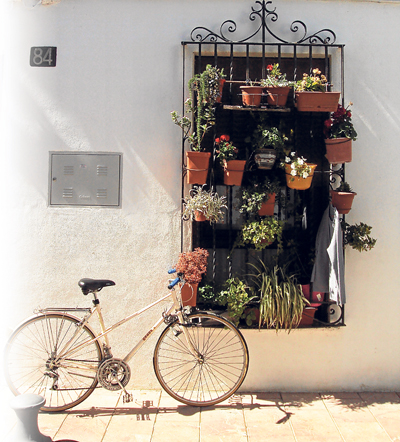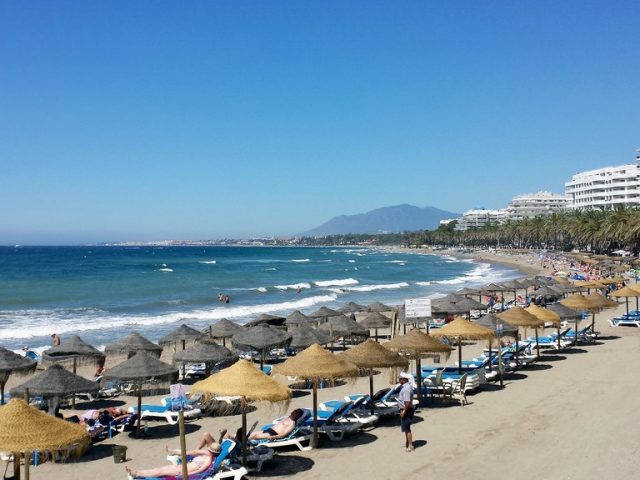- Have any questions?
- +34 951 273 575
- info@allaboutandalucia.com
Estepona: The white-village-on-sea

Benalmadena: A different spirit
June 23, 2016
Somewhere over the rainbow… in Torremolinos
June 27, 2016
IDYLLIC: A back street in Estepona’s Old Town
WANDERING the narrow streets of Estepona’s old town during siesta time provides the greatest clue to its enduring Spanishness.
While many other towns along the Costa del Sol have adopted northern European working hours in a bid to satisfy the hoards of tourists, it is still largely adhered to in Estepona.
The only signs of life in the deserted back alleys of the old town were the occasional cat and the odd hushed conversation coming from behind shuttered windows.
With the white-washed houses bedecked in window boxes bursting with vividly coloured flowers, I could easily have been in one of the celebrated pueblos blancos further inland.
Enjoying a coffee in the shade of an orange tree in a pretty plaza, I realised just how much more gradual the town’s development had been compared to the rest of the coast.
One long-term expatriate resident Sonia Longman, 67, explained how in the 1950s there was practically nothing in Estepona apart from a smelly fish factory, where supermarket Carrefour is today.
“When we used to get a taxi from our home in Torremolinos to Gibraltar I remember my mum giving us hankies with cologne as we passed to mask the smell of the glue made from fish oil,” she recalls.
Longman and her sister, who later moved there and have run the local English bookshop Longmans for decades, started life in the town working on Spanish newspaper, Sol de Espana.
Working under the tutelage of Lord Cowley, who was a direct descendant of the Duke of Wellington, they were given the job of producing an English page within the paper every day.
“We always liked to push the boundaries and even once got reported to the Bishop of Malaga for using a photograph of a sexy girl in a bikini climbing a tree.
“It was in the days of dictator Franco and the editor was summoned to Malaga to receive a dressing down from the Bishop,” she continues.
“He got such a ticking off that we were forced to fill all the middle bits of every shot of women in bikinis with black felt pen so it looked like they had bathing suits on!”
She also remembers how – after moving to the town in the 1960s – her sister’s donkey was ‘towed away’ by the local police for eating flowers in the main square.
“It was taken to the slaughterhouse and my sister had to literally beg the fat local policeman to give her a lift there to rescue it just in time.”
How things have changed.
In line with the growth of most of the Costa del Sol, the town and its surrounding area has become a magnet for property developers, estate agents, golfers, professional footballers and celebrities.
The marina now holds berths for over 250 yachts and the town boasts around 25,000 people residing there all year round.
A distant cousin of its more affluent neighbour, Marbella, and situated 40kms from Gibraltar, the town is part upmarket tourism and part package holiday resort.
But, what one really notices about Estepona is the fact that it remains resolutely a Spanish town, conserving much of its old part, that is in every way as attractive as Marbella.
“It has a distinct Spanish flavour,” explains local shopowner Hugh Thompson, from stylish furniture and antique shop Retro.
Fellow expat Gwilym Rhys Jones, from internet/computer company Surweb agrees.
“It has never lost its soul like some Costa towns,” he says.
Originally given the title of Estebbuna by the Romans, the town is littered with historic monuments from old Phoenician and Roman burial grounds to splendid castles.
Built on the old Roman road now the paseo, the town was destroyed by the conquering Christians in the 15th century and rebuilt by Queen Isabella and King Ferdinand a century later.
In 1729 Philip V granted the town a charter for 600 families and the town has continued its growth to this day.
The old monuments are still very much in evidence from the scattering of watchtowers warding off the Moorish invaders to the Arab-built clock tower and the 16th century castle ruins, which are worth a visit.
The best is the old Franciscan monastery which is now the Church of our Lady of Redemption.
If you ask nicely you may still be allowed to walk to the top of the tower and enjoy the vista of the whole town and mountains inland.
Modern Estepona still maintains its ancient ambience and does not seem overwhelmingly saturated with foreign investment.
Unlike, say, Fuengirola and its fish alley, there are only a handful of English bars in the old town and along the paseo. Local Spanish bars take precedence and there is plenty of good tapas to be had at very cheap prices.
The town also boasts one of the best beaches on the coast, the Playa de la Rada, which won a prestigious EC blue flag in 2009. Lining this golden stretch of coastline are a number of well known chiringuitos that have been
established since the mid sixties.
In the summer, those in the know will flock to this beach ahead of its mainstream counterparts down the road in Marbella.
As holidaymakers fight to grab some limited towel space in Puerto Banus, Estepona’s sun worshippers often have enough space to draw up their own volleyball courts in the sand.
Others, such as expat Pauline Olivera prefer the ‘secret beach’ Playa del Cristo, just up the coast. “It is one of the only unspoilt little bays left on the coast,” she says. “It is so nice I chose to get married there.”
However, not only is the town great for sun-seekers but it also serves up a storm for fans of quality sea food.
Even now, dozens of small fishing boats leave the calm waters in the early hours, coming back laden with their catches.
Back in the olden days the place had a fabulous restaurant called the Yellow Book.
This alternative hangout was based around the notorious drawings of one local artist which had to be censored for their explicit content.
While they didn’t leave anything to the imagination, famous guests included Michael Parkinson, Jimmy Tarbuck, Ronnie Corbett and the late Frank Carson, who had a house near the marina.
If you are celebrity-spotting today, keep your eyes peeled for the much-loved Cilla Black who occasionally pops over, as well as Spain’s highest-paid matador Jose Tomas, who lives in the town with his girlfriend and young baby, born in November.
Even wrinkly rocker Rod Stewart used to live a few minutes drive away, up on the Casares road, where you will find a series of spectacular restaurants.
These days, however, you are more likely to bump into footballers trying to improve their handicap on a golfing break at El Paraiso or Valle Romano.
Either way, thankfully much of Estepona’s old remnants remain intact, as a stroll through the old town confirms.
Just don’t go wandering too far as it may just bring you back into modern times.




